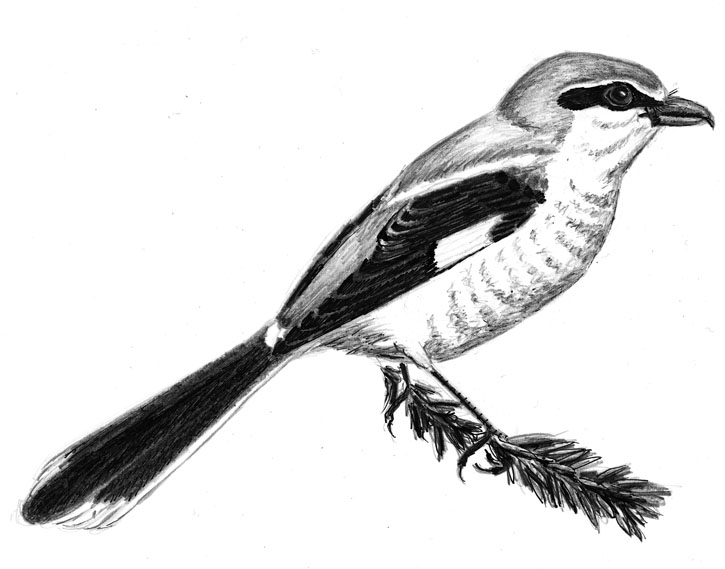
Dear Bird Folks,
After reading your recent column about finding one new bird for the year, I decided my goal bird for 2019 will be the Northern Shrike. I’ve always wanted to see one of these unusual birds. Any suggestions for how I might find one?
– Eric, Centerville, MA
It depends, Eric,
It all depends upon what sort of experience you are hoping to have. You have two choices. One is to go for walks, in appropriate habitat, and see what you see. Whether you find something common or unusual is basically a matter of luck. The other method is to fire-up the internet and read about what birds other people have been seeing. Cornell’s eBird is the site most birders use to post (and check out) bird sightings. In your case, you should look for postings of Northern Shrikes in Barnstable County. If you discover that someone has reported a shrike near, say, the Centerville Pie Company, all you have to do is run over there and your search would be over. Keep in mind, knowing exactly where a specific bird is going to be is like skipping ahead to the last page of a mystery novel. It takes the surprise out of it. Or you might also discover that you are too late, the bird has moved on and you’ve missed it. But at least in this particular case, you could drown your sorrows in a piece of pie, which wouldn’t be so bad.
Sometimes a bird’s name is misleading. For example, the Northern Cardinal breeds as far south as Central America, making it hardly a true “northern” bird. The same thing can be said for the Northern Flicker, which happens to be the state bird of Alabama, a state that isn’t at all northern, and probably wants you to know that. But the Northern Shrike really does earn its title. It nests in the remote boreal forests of Canada and Alaska. Eventually, winter forces these birds to leave their summer homes and migrate south, towards us. Some species, Canada Geese, for example, have a predictable fall migration pattern. We always know where and when they’ll be arriving. Such is not the case with Northern Shrikes. The Checklist of the Birds of Cape Cod refers to shrikes as “erratic” winter visitors. (And I thought erratic visitors were only here in the summer.)
Before I tell you the best places on the Cape to look for shrikes, I should probably inform everyone else about this peculiar species and what makes it a bird worth searching for. To begin with, shrikes are robin-sized songbirds. Not very exciting, right? I should also mention that they are deadly robin-sized songbirds. That’s right, “deadly.” Instead of feeding on worms and berries, like robins, shrikes catch and eat small mammals, reptiles and other songbirds, including, ironically, robins. They are literally songbirds…of prey. But while most other birds of prey (hawks, owls, etc.) come equipped with lethal talons, shrikes have the traditional little birdy feet. (BTW, this next part is a little gruesome, so you probably shouldn’t read it to any children, friends with weak stomachs or vegetarians.) Instead of using nasty claws, shrikes use a hook on the end of their beak to do the dirty work. When prey is caught, shrikes quickly dispatch it with a bite to the nape of the neck, instantly severing its vertebrae. If you think that’s gross (and if you don’t, why not?), this next part should curl your toes. When hunting is good, a shrike will catch more food than it needs. Not wanting to upset its mother and waste food, the shrike will store the unlucky creatures for later consumption. After a shrike makes a kill, it will impale the victim on a nearby thorn, where it will hang until the bird feels hungry again. Some folks say this behavior is barbaric. Have these people never looked in the window of a butcher shop? I’m just saying.
Many birds spend their days skulking about a marsh, or hiding in deep thickets, but not shrikes. When hunting, they tend to sit on exposed posts, or treetops or wherever they can survey the area for prey. This makes spotting a shrike relatively easy. A few years ago, my wife and I were driving through the Province Lands of Provincetown, when I spotted a mockingbird sitting on the top of a pitch pine. As we drove past, I noticed that this particular mockingbird was a little fatter than usual. I instantly locked up the brakes. Most wives would have been startled by such drama, but my wife didn’t even look up from what she was reading. She just mumbled in a quiet voice, “I have a feeling we are about to back up.” We certainly were and my hunch was correct. The bird on the pine tree was indeed a Northern Shrike. I was thrilled. After hearing the enthusiasm in my voice, my wife looked up for a brief moment, before returning to her reading. (If she doesn’t find the bird first, she’s not interested.)
Winter is the best time of year to look for Northern Shrikes, Eric. I suggest you try wide-open locations, such as Crane Wildlife Management Area, Cape Cod Organic Farm, Fort Hill or the aforementioned Province Lands. Look for a mockingbird-looking bird, sitting on an exposed branch. This seems to be a good year for shrikes on Cape Cod, as I’ve read about several sightings already. But I won’t tell you exactly where they are, just in case you want to be surprised. I will tell you, however, that none of the locations included the Centerville Pie Company. Nevertheless, you should go there and take a look. And while you are looking, get yourself a pie. At least, that’s what I would do.